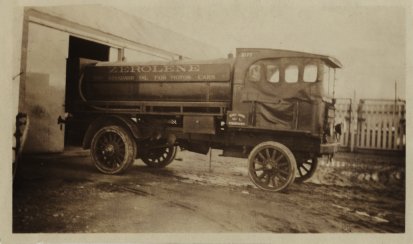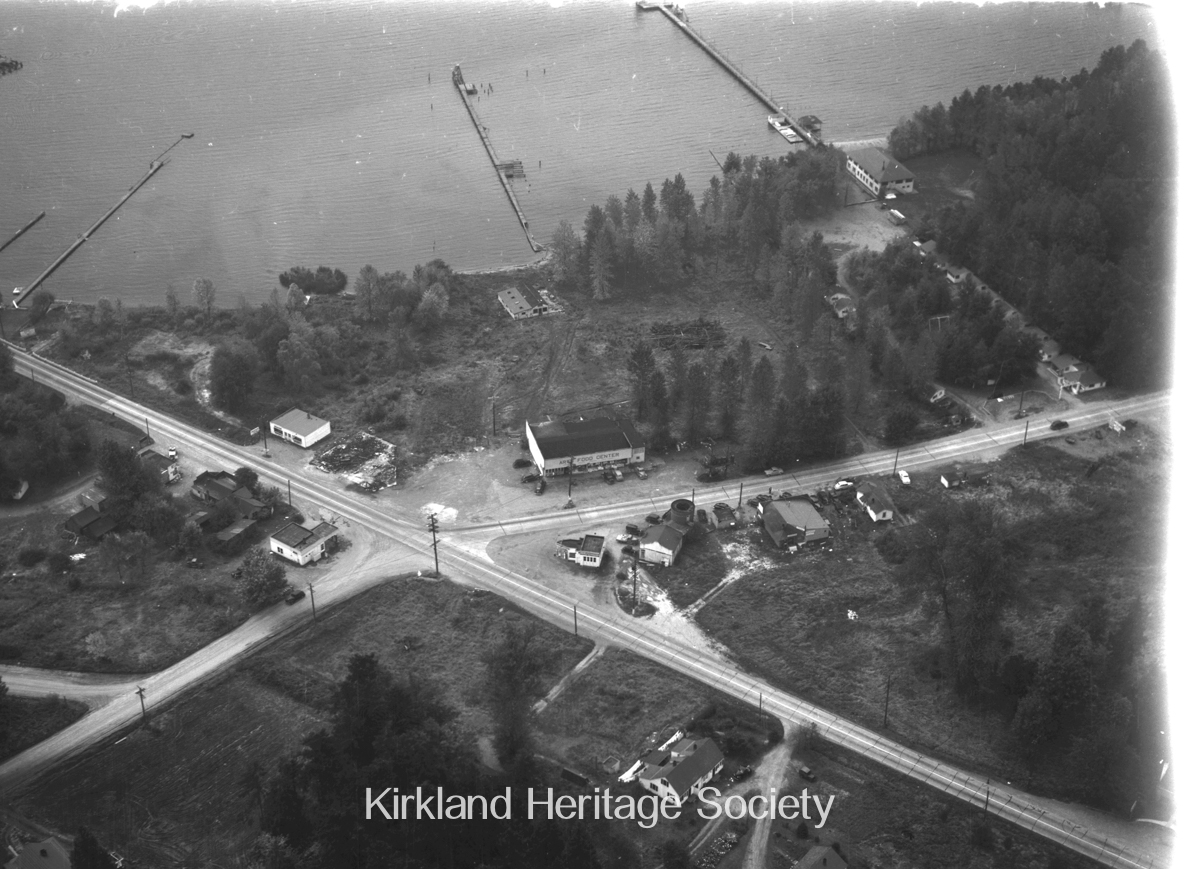Up until July 7, 1914, the only ghastly and propelled vehicle I had driven was a motorcycle that I owned. I was driving a horse-drawn tank wagon for the standard oil Company in Seattle when they wanted me to go to Everett and a truck. I was leery at first as it was a 5 ton Packard chain drive with solid tires. When fully loaded it weighed 10 ton. At the time there were no paved roads and those that existed were not made for such a load.
When I left Seattle the standard oil Company had 45 head of horses, two fuel oil trucks and one Alco gasoline delivery truck made by the American locomotive Company. They are no longer manufacturing trucks.
The model T Ford was the biggest seller and most popular car at this time. Many higher priced cars were on the market such as the Winton, Lozier, Franklin Pierece Arrow, Packard, Stevens Duryea, EMF Chandler, Hudson, Apperson, Overland, Oldsmobile, Willys Knight, Peerless, Pope Hartford, Marmon and Thomas Flyer. Most automobiles were jacked up in the garage for the winter.
I was in Portland working as a hotel bellhop during the Lewis and Clark world’s fair in 1905. When an Oldsmobile arrived in town after a cross-country trip from New York. You would have thought it was a big chunk of mud as I did when I saw it.
From then the automobile began to come into its own. At that time there were wagon roads and they were rough roads. Most people traveled by train or boat.
Between Seattle and Bellingham trains and boats handled nearly all the traveling public. I worked on the sternwheeler state of Washington that left Seattle at 10 p.m. and arrived in Bellingham at 8 a.m.. There were other boats on the run; the Utopia, Watcom, Dode and 2 sidewheelers, the Sehome and George E. Starr. The great Northern and the Northern Pacific ran trains between the two cities also.
Between Seattle and Tacoma that was both service about every four hours and Tacoma enter urban ran about every hour. The Northern Pacific was the only road giving service between Seattle and Portland. Everett and Seattle were served by boat and the great Northern Railroad.
To California we had a very good steamer service. To name some: The Queen, Umetilla, Walla Walla, Seantor and later on the H F Alexander, a luxury liner. You had to go to Alaska by water. I worked on the SS Jefferson the summer of 1906. We called in Ketchikan, Juneau, Douglas, Haines, Metlakatia and Skagway.
About 1911 the state and federal governments begin to talk about good roads as the automobile was becoming popular. Up to about 1913 this was just what our transportation facilities consisted of. They then started improving the roads but it was not until about 1960 that they started painting them with concrete. The roads at this time were gravel coated and what we called “washboard”, for the grader would leave ridges in them. It made rather rough going and of course they were very dusty the motorist had to wear goggles and a duster and cape. Nearly all the first automobiles were what we called him touring cars. They were equipped with curtains that did not keep the dust out and a top that could be let down.
 The road between Seattle and Tacoma was corrected and it was a long 35 Mile Drive. I am sure at that time you drove through a cow yard at one part of it. Also you went through South Seattle, Georgetown, South Park and then Duwamish, Allen, O’Brien, Sumner, and Puyallup. It was bricked for about 5 miles and black tops on the way, but it still was considered a long trip to Tacoma and back.
The road between Seattle and Tacoma was corrected and it was a long 35 Mile Drive. I am sure at that time you drove through a cow yard at one part of it. Also you went through South Seattle, Georgetown, South Park and then Duwamish, Allen, O’Brien, Sumner, and Puyallup. It was bricked for about 5 miles and black tops on the way, but it still was considered a long trip to Tacoma and back.
In the fall of 1915, Snohomish voted to pave several miles with a 16 foot wide concrete road, which had to be widened later on. In the spring of 1916, they started paving the road between Marysville and Everett, a distance of 10 miles. During this time we had to go over the trestle to Cavallero’s Corner and then north over the Sunnyside hill to Marysville.
The tank truck I was driving in 1914 was the first of its kind in Snohomish County and it created quite a sensation the first time I went to Arlington. It was also the heaviest truck in Snohomish at that time.
In the wintertime after a hard freeze large soft spots would heave up the road. Between Marysville and Everett it would get so muddy that I would carry 4 planks on top of the truck to use for a road in the soft spots. I remember one day I had no trouble going to Arlington with a full load, but coming back empty I got stuck 3 times. That just shows how fast the roads would thaw out.
I have had to stay over all night at times. One time in particular I recall they were paving the road near Arlington and had a detour of about quarter mile around it. I hired a team driver and rigging slingers and we left Everett about 8 a.m. arriving in Arlington 5 p.m. I spent the night there and the next morning I’ve begun to wonder how I was going to get back, as I had made the detour impassable. There was another road but there were two bridges on the that were not very strong. Since I had to get back I got off the truck and went under the bridge to look it over and I discovered it was made from cedar logs. It looked risky but I made it okay although I heard creaking as I started across. I called the county commissioner in the county fixed it up but they also tried to bar the truck. Actually it was really an eye opener for the commissioner of the future of heavy traffic.
On another trip I was making to Monroe, I got stuck and had to stay at a farmer’s house. When you get into deep mud chains would get so tight he could not move. That meant jacking the truck up and removing the chains to get out of the mud. Some job!
The winter of 1915-16 was very cold and by February 3rd we had nearly 4 feet of snow on the ground. I started for Arlington one day and got as far as Marysville, only to discover that there had been no travel beyond that point. My helper Jesse Sears, who passed away sometime ago, and I managed to break the road to Arlington. The stage from Arlington could then start again after having been snowbound for a week.
The snowcapped following until about February 7th when I started for Snohomish with a helper by the name of Chauncy Richardson, who now lives in California. Snohomish was getting low on kerosene so I loaded the truck the night before and we left Everett at 7 a.m. on the solid tires I had to use logging chains held together with a wire, which was plentiful then. By 6 O’Clock that night we were still 3 miles from Snohomish and the truck could hardly move. I could gain a few feet by backing up and ramming. We went to a farmhouse and ask them about putting us up for the night but since they had a large family there was no room. We did get a good meal though. The farmer said he was going to try to get his mouth to Everett by sleigh and we were welcomed to go with him. We did a little way but began to get cold so we walked the 7 miles to Everett and snow up to our knees.
On the following Sunday week have three teams, which together with the truck’s power managed to get us in Snohomish. This is not only should interurban had managed to clear their tracks, so after hiring a farmer with a sleigh and unloading the truck into 5 10 gallon cans, I hauled it to the Snohomish merchants who were very glad to get another supply. I drove the truck back to Everett on Sunday afternoon.
Transcripted from Stan Denton’s father Harry’s hand written pages. Part of the Stan Denton collection January 2009.


